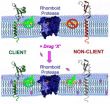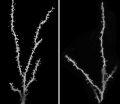(Press-News.org) To sexually objectify a woman is to focus on her body in terms of how it can provide sexual pleasure rather than viewing her as a complete human being with thoughts and feelings. While objectification has long been considered a problem in the media, how does it affect individual romantic relationships? New research published in Psychology of Women Quarterly, a SAGE journal, finds that more objectification of a female partner's body is related to higher incidents of sexual pressure and coercion.
Researchers Laura R. Ramsey and Tiffany Hoyt surveyed 119 males and 162 females who had been in heterosexual relationships. They found that men who frequently objectify their partner's bodies by excessively focusing on their appearance are more likely to feel shame about the shape and size of their partner's body which in turn is related to increased sexual pressure (i.e., the belief that men expect sex and that it is a woman's role to provide sex for her partner) and sexual coercion, both in general and through violence and manipulation.
"Being more aware of how and when one thinks of their partner as an object, sexually or otherwise, could help relationship partners avoid sexual pressure and coercion and increase communication and respect within their relationship," the researchers wrote.
The data also supported the idea that women internalize objectification from their partners. This internalization is related to feeling shame about their bodies, a decrease in asserting themselves, and a decrease in expressing what they do and do not want to do sexually.
"Acknowledging objectification in their relationships may help women realize when they lack agency and allow them to resist and avoid sexual pressure," the researchers continued. "Furthermore, thinking about objectification in terms of agency and sexual pressure could also have implications for women's relationship satisfaction, both sexual and otherwise. Women who feel that they have no control and who experience sexual pressure from their partner will not be as satisfied as women who feel like they have control over their body and the decisions in the relationship."
The researchers discussed additional ideas for decreasing objectification in heterosexual relationships.
"Activists should continue their work reducing the objectification of women in our culture, such as through the recognition and removal of objectifying images in the media. However, as male objectification of women is more common than female objectification of men, the onus is on men to reduce objectification and sexual violence. It is of utmost importance that activists and educators work with men to reduce the objectification of women, both in general and in the context of romantic relationships."
INFORMATION:
Find out more by reading the full article, "The Object of Desire: How Being Objectified Creates Sexual Pressure for Women in Heterosexual Relationships," available free for a limited time here: http://pwq.sagepub.com/content/early/2014/07/31/0361684314544679.abstract
Psychology of Women Quarterly (PWQ) is a feminist, scientific, peer-reviewed journal that publishes empirical research, critical reviews and theoretical articles that advance a field of inquiry, brief reports on timely topics, teaching briefs, and invited book reviews related to the psychology of women and gender.
Impact Factor: 1.907
Ranked: 1 out of 39 in Women's Studies and 34 out of 127 in Psychology, Multidisciplinary
Source: 2013 Journal Citation Reports® (Thomson Reuters, 2014)
SAGE is a leading international publisher of journals, books, and electronic media for academic, educational, and professional markets. Since 1965, SAGE has helped inform and educate a global community of scholars, practitioners, researchers, and students spanning a wide range of subject areas including business, humanities, social sciences, and science, technology, and medicine. An independent company, SAGE has principal offices in Los Angeles, London, New Delhi, Singapore and Washington DC. http://www.sagepublications.com
Objectification in romantic relationships related to sexual pressure and coercion
2014-08-21
ELSE PRESS RELEASES FROM THIS DATE:
Primary care physicians can be critical resource for abused women in rural areas
2014-08-21
Many primary care physicians in rural communities do not routinely screen women for intimate partner violence (IPV), according to Penn State medical and public health researchers. Rural women who are exposed to such violence have limited resources if they seek help.
"Rural health care providers are uniquely positioned to help women," said Jennifer S. McCall-Hosenfeld, a primary care physician and assistant professor of medicine and public health sciences, Penn State College of Medicine. "However, in rural settings, it might be even more important for physicians to step ...
Viruses take down massive algal blooms, with big implications for climate
2014-08-21
Algae might seem easy to ignore, but they are the ultimate source of all organic matter that marine animals depend upon. Humans are increasingly dependent on algae, too, to suck up climate-warming carbon dioxide from the atmosphere and sink it to the bottom of the ocean. Now, by using a combination of satellite imagery and laboratory experiments, researchers have evidence showing that viruses infecting those algae are driving the life-and-death dynamics of the algae's blooms, even when all else stays essentially the same, and this has important implications for our climate.
According ...
Biologists reprogram skin cells to mimic rare disease
2014-08-21
Johns Hopkins stem cell biologists have found a way to reprogram a patient's skin cells into cells that mimic and display many biological features of a rare genetic disorder called familial dysautonomia. The process requires growing the skin cells in a bath of proteins and chemical additives while turning on a gene to produce neural crest cells, which give rise to several adult cell types. The researchers say their work substantially expedites the creation of neural crest cells from any patient with a neural crest-related disorder, a tool that lets physicians and scientists ...
Sequence of rare kidney cancer reveals unique alterations involving telomerase
2014-08-21
HOUSTON – (Aug. 21, 2014) – An international scientific collaboration led by Baylor College of Medicine has revealed clues about genetic alterations that may contribute to a rare form of kidney cancer, providing new insights not only into this rare cancer but other types as well.
The collaboration, a project of the National Institutes of Health's Cancer Genome Atlas initiative, completed the sequence of chromophobe renal cell carcinoma and published the results today in the journal Cancer Cell.
"The Cancer Genome Atlas is a federally funded national effort that has ...
Some anti-inflammatory drugs affect more than their targets
2014-08-21
Researchers have discovered that three commonly used nonsteroidal anti-inflammatory drugs, or NSAIDs, alter the activity of enzymes within cell membranes. Their finding suggests that, if taken at higher-than-approved doses and/or for long periods of time, these prescription-level NSAIDs and other drugs that affect the membrane may produce wide-ranging and unwanted side effects.
More positively, the researchers say, their work provides the basis for a test that drug developers can use to predict and perhaps avoid these side effects in new medicines they make. A summary ...
Children with autism have extra synapses in brain
2014-08-21
NEW YORK, NY (August 21, 2014) — Children and adolescents with autism have a surplus of synapses in the brain, and this excess is due to a slowdown in a normal brain "pruning" process during development, according to a study by neuroscientists at Columbia University Medical Center (CUMC). Because synapses are the points where neurons connect and communicate with each other, the excessive synapses may have profound effects on how the brain functions. The study was published in the August 21 online issue of the journal Neuron.
A drug that restores normal synaptic pruning ...
Research explains how cellular guardians of the intestine develop
2014-08-21
Even the most careful chosen meal can contain surprises. To defend against infectious microbes, viruses or other potential hazards that find their way to the intestines, a dedicated contingent of immune cells keeps watch within the thin layer of tissue that divides the contents of the gut from the body itself.
New research at Rockefeller University sheds light on the development of a unique class of immune cells known as intraepithelial lymphocytes (IELs) that reside in this critical interface. The findings, published August 21 in Immunity, may help lead to new insights ...
Alternate mechanism of species formation picks up support, thanks to a South American ant
2014-08-21
A newly-discovered species of ant supports a controversial theory of species formation. The ant, only found in a single patch of eucalyptus trees on the São Paulo State University campus in Brazil, branched off from its original species while living in the same colony, something thought rare in current models of evolutionary development.
“Most new species come about in geographic isolation,” said Christian Rabeling, assistant professor of biology at the University of Rochester. “We now have evidence that speciation can take place within a single colony.”
The findings ...
Mouse model for epilepsy, Alzheimer's gives window into the working brain
2014-08-21
(SALT LAKE CITY)—University of Utah scientists have developed a genetically engineered line of mice that is expected to open the door to new research on epilepsy, Alzheimer's and other diseases.
The mice carry a protein marker, which changes in degree of fluorescence in response to different calcium levels. This will allow many cell types, including cells called astrocytes and microglia, to be studied in a new way.
"This is opening up the possibility to decipher how the brain works," said Petr Tvrdik, Ph.D., a research fellow in human genetics and a senior author ...
Hacking Gmail with 92 percent success
2014-08-21
RIVERSIDE, Calif. — A team of researchers, including an assistant professor at the University of California, Riverside Bourns College of Engineering, have identified a weakness believed to exist in Android, Windows and iOS mobile operating systems that could be used to obtain personal information from unsuspecting users. They demonstrated the hack in an Android phone.
The researchers tested the method and found it was successful between 82 percent and 92 percent of the time on six of the seven popular apps they tested. Among the apps they easily hacked were Gmail, CHASE ...





